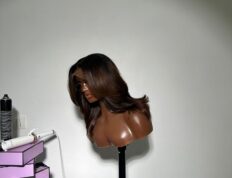The right wig density is the secret to a realistic appearance. A wig that’s too dense can look unnatural and feel bulky, especially if it doesn’t match your natural hair type. The amount of hair also affects the wig’s weight and breathability. A lighter wig is much more comfortable for all-day wear, particularly in warmer weather.
Here’s a simple guide to the most common densities:
- Light Density (80%-100%): This mimics the natural fullness of fine or thinning hair. A light density wig is perfect for a subtle, everyday look. It’s incredibly lightweight and comfortable.
- Natural Density (120%-130%): This is the most popular choice as it closely resembles the thickness of an average head of hair. It offers a perfect balance of volume and realism, making it a versatile option for any style.
- High Density (150%+): For those who love big, voluminous hair with plenty of bounce and movement, a high density wig is ideal. It’s a great choice for glamorous looks, but be aware that the extra hair adds weight.
Choosing the right wig density is a personal decision based on your preferred style and lifestyle. Whether you want a light, natural look or a bold, high-volume style, understanding these percentages will help you find a wig that feels and looks perfect for you.
Shop our human hair units
Related Blog Post
- How to Shampoo Your Wig Properly
- Can Lace Wigs Be Worn Daily?
- Wig Etiquette 101
- Brazilian vs Slavic Hair: A Guide to Choosing the Right Hair Type
- Closures – Which One is Right for You?
- How to Care for Your Natural Hair
- How to Detangle Your Wig the Right Way
- How to Deep Condition Your Wig with a Hair Mask






